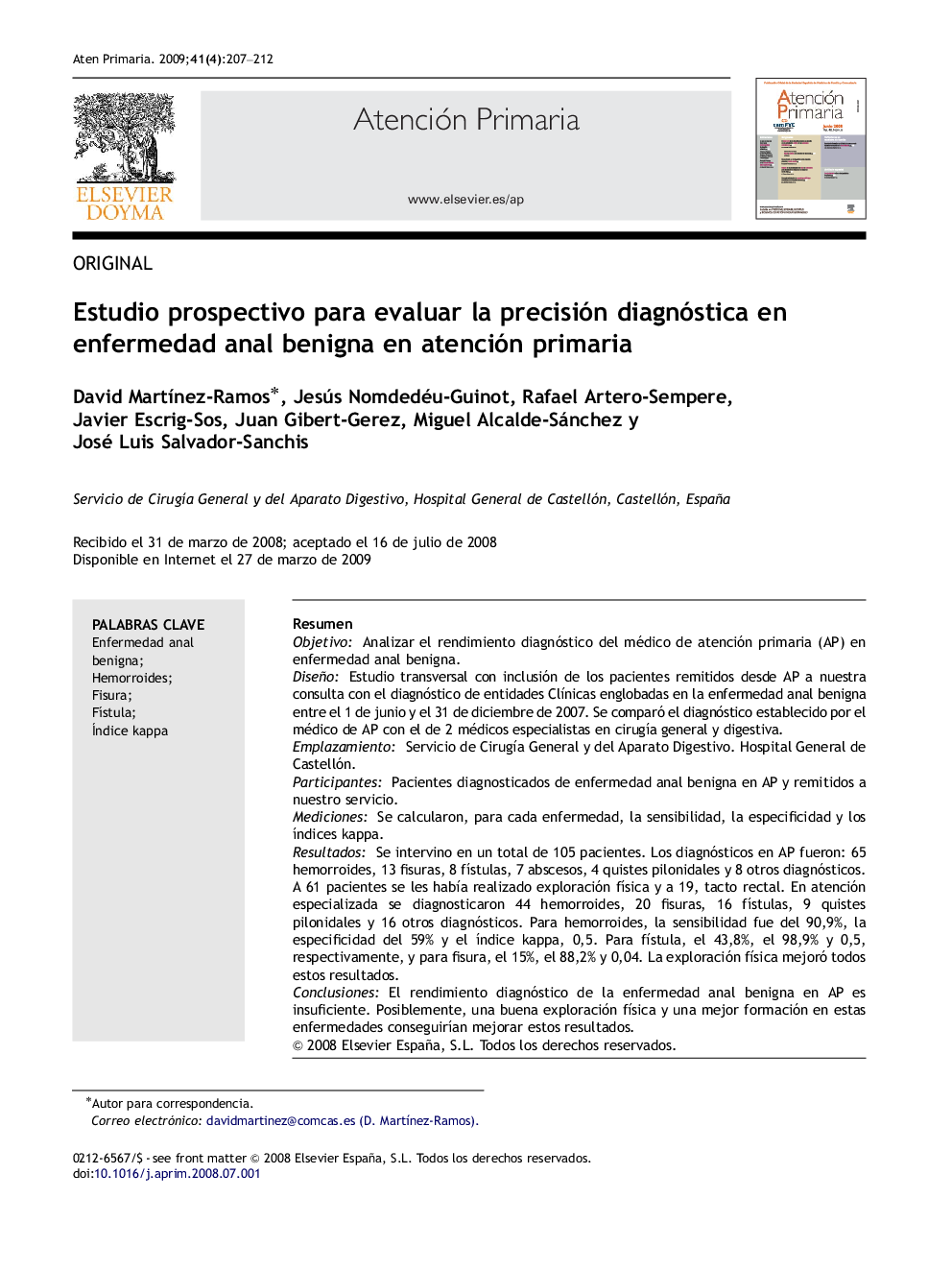| Article ID | Journal | Published Year | Pages | File Type |
|---|---|---|---|---|
| 3458144 | Atención Primaria | 2009 | 6 Pages |
ResumenObjetivoAnalizar el rendimiento diagnóstico del médico de atención primaria (AP) en enfermedad anal benigna.DiseñoEstudio transversal con inclusión de los pacientes remitidos desde AP a nuestra consulta con el diagnóstico de entidades Clínicas englobadas en la enfermedad anal benigna entre el 1 de junio y el 31 de diciembre de 2007. Se comparó el diagnóstico establecido por el médico de AP con el de 2 médicos especialistas en cirugía general y digestiva.EmplazamientoServicio de Cirugía General y del Aparato Digestivo. Hospital General de Castellón.ParticipantesPacientes diagnosticados de enfermedad anal benigna en AP y remitidos a nuestro servicio.MedicionesSe calcularon, para cada enfermedad, la sensibilidad, la especificidad y los índices kappa.ResultadosSe intervino en un total de 105 pacientes. Los diagnósticos en AP fueron: 65 hemorroides, 13 fisuras, 8 fístulas, 7 abscesos, 4 quistes pilonidales y 8 otros diagnósticos. A 61 pacientes se les había realizado exploración física y a 19, tacto rectal. En atención especializada se diagnosticaron 44 hemorroides, 20 fisuras, 16 fístulas, 9 quistes pilonidales y 16 otros diagnósticos. Para hemorroides, la sensibilidad fue del 90,9%, la especificidad del 59% y el índice kappa, 0,5. Para fístula, el 43,8%, el 98,9% y 0,5, respectivamente, y para fisura, el 15%, el 88,2% y 0,04. La exploración física mejoró todos estos resultados.ConclusionesEl rendimiento diagnóstico de la enfermedad anal benigna en AP es insuficiente. Posiblemente, una buena exploración física y una mejor formación en estas enfermedades conseguirían mejorar estos resultados.
ObjectiveTo analyse the diagnostic performance of the primary care (PC) doctor in benign anal diseases.DesignCross-sectional study including patients referred to our clinic from PC with the diagnosis of clinical conditions pertaining to benign anal diseases between 1st June and 31st December 2007. The diagnosis established by the PC doctor was compared with that of 2 medical specialists in general and digestive diseases surgery.SettingDepartment of General Surgery and Digestive Diseases. Castellon General Hospital.ParticipantsPatients diagnosed with a benign anal disease in PC and referred to our department.MeasurementsThe sensitivity, specificity and kappa index was calculated for each disease.ResultsA total of 105 patients were included. The diagnoses were: 65 haemorrhoids, 13 fissures, 8 fistulas, 7 abscesses, 4 pilonidal cysts, and 8 other diagnoses. A physical examination was carried out on 61 patients and 19 had a rectal examination. In AE, 44 haemorrhoids, 20 fissures, 9 pilonidal cysts were diagnosed and there were 16 other diagnoses. For haemorrhoids the sensitivity was 90.9%, the specificity 59%, and the kappa index was 0.5. For a fistula, it was 43.8%, 98.9% and 0.5, respectively and for a fissure, 15%, 88.2% and 0.04. The physical examination improved all these results.ConclusionsThe diagnostic performance of benign anal diseases in PC is insufficient. A good physical examination and improved training in these diseases could possibly improve these results.
